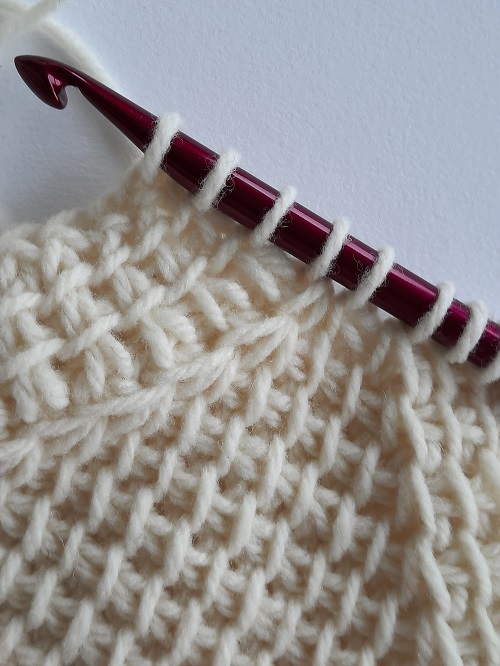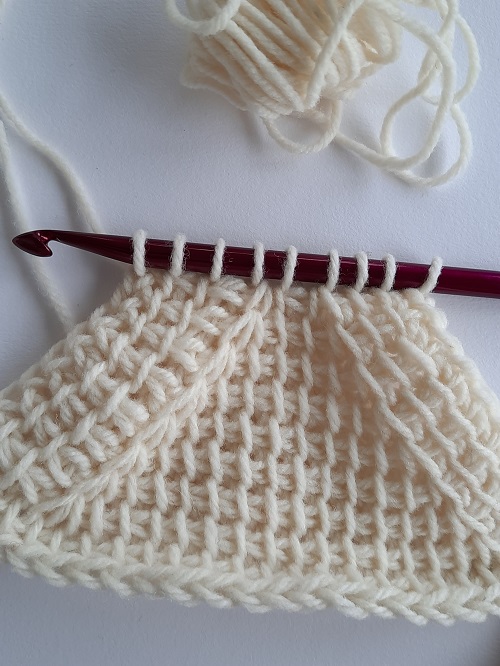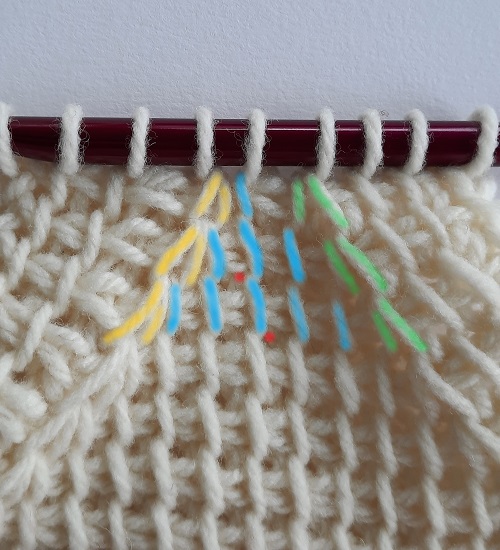How to make symmetrical decreases leaning to the left and to the right in Tunisian crochet? In this article, I’m showing you a technique with the Tunisian simple stitch as the main stitch for the sample. And I explain why symmetry with the simple stitch is not an easy thing to create. Keep in mind there are other options with other Tunisian stitches.

Return pass decreases
To make a decrease on the return pass, instead of making a “yarn over, pull through 2”, pull the yarn over through 3 loops. In other words, the yarn over goes through the return pass chain and 2 loops that you picked up on the previous forward pass.
When making the next forward pass, you’ll notice, when you reach the place where you closed 3 loops together, that 2 vertical bars are leaning towards each other. There is no chain in between the 2 vertical bars. Just consider these 2 bars as one unique stitch. Insert the hook under these 2 bars, yarn over and pull up a loop. In the previous row you had 2 loops, now you have only 1 loop.
If you make that same return pass decrease systematically after and before the decreases in the previous row, you get this:

Decreases aligned to the left and to the right don’t look the same at all. They are the same. Yet they have a different visual.
Symmetrical decreases Tunisian simple and twisted up stitches
To make symmetrical decreases, proceed as follows:
- a simple stitch under the 2 vertical bars closed together on the previous return pass for a decrease leaning to the left;
- a twisted up stitch under the 2 vertical bars just before the “yarn over pull through 3” on the previous return pass for a decrease leaning to the right.
You get this:

Decreases are symmetrical. Yet the whole thing does not look like symmetry is perfect. There is a little something not quite right. This is due to the Tunisian simple stitches on each side of the decreases.
The Tunisian simple stitch is not a symmetrical stitch

Have a good look at the photo here above. Compare the decreases highlighted in green (simple) and in yellow (twisted up). They are symmetrical.
- Decreases in green lean to the left. Stitches come out from the right side of the previous stitch.
- Decreases in yellow lean to the right. Stitches come out from the left side of the previous stitch.
What distorts the perception of symmetry is all the simple stitches before and after the decreases. The red dots on the photo indicate the bottom and top of a vertical bar. Actually this bar is not really vertical. It’s oblique, slightly leaning to the left. The Tunisian simple stitch is not a symmetrical stitch.
Decreases in video
I posted a video in English on my YouTube channel to show how to make the 2 samples documented in this article.
